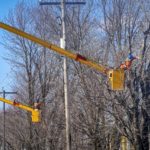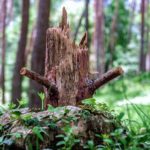Tree trimming is essential to maintaining your landscape’s health and beauty. However, it’s important to remember that this activity is more complex than it may seem. It can be dangerous and even deadly without the proper knowledge and tools.
In this guide, luckily, you’ll find everything you need to know about the right techniques, tools, and safety tips to help you get the job done safely and effectively. Keep on reading to learn more.
Tree Trimming: A Definition
Tree trimming is the art of selectively removing branches and stems from a tree to improve its structure, shape, or health. It can be done using different tools like a pole pruner, ladders, and chainsaws. Tree trimming is an essential skill for any arborist or tree care professional, as well as it gives different benefits like:
- Improved Appearance: Regularly trimming your trees will help them look healthier, better maintained, and more aesthetically pleasing. It helps keep trees from becoming overgrown, giving them a neat, manicured look.
- Safety Is Ensured: When done with pruning, trimmed trees are less likely to break in storms or heavy winds, reducing the risk of falling on power lines or other property. Trimming makes it easier to spot any potential problems in the branches, such as disease or rot, that could cause branches to snap off suddenly.
- Improved Health: Trees naturally shed dead branches and damaged limbs and trimming helps keep the process going by removing any excess debris or deadwood. This can help your tree stay healthy by reducing the weight it must support and giving it more space to grow.
- Improved Growth: Trimming helps encourage new growth in trees by stimulating new bud formation too. It can help create a better branching structure for your tree, which gives it more stability and allows more sunlight to reach its innermost leaves.
Trimming techniques should be carefully considered before any work is carried out. If done incorrectly, it can cause damage to the tree and even shorten its lifespan. Therefore, it’s crucial to understand the various techniques employed when trimming a tree so you can reap its many advantages.
Trimming Trees Safely: The Basics
Tree trimming is an important task that can help keep your property looking its best and reduce the risk of damage to your home, yard, and other trees. Nevertheless, it’s essential to take safety precautions when trimming trees, as it can be dangerous if not done correctly.
The following steps will help ensure safe tree trimming:
1. Know The Most Common Tree Trimming Accidents
Tree trimming can be dangerous if proper safety precautions aren’t taken. Thus, it’s essential to understand the most common tree-trimming accidents so you can take steps to avoid them. There are three most common tree-trimming accidents everyone should know. These are electrocution, falls, and getting struck by tree limbs.
-
Falling From Trees
Tree trimming is risky, and it’s common for people to fall out of trees while trying to trim them. According to statistics, falls are the leading cause of death and injury in tree-trimming accidents.
The usual causes of falling while trimming trees can be attributed to loss of balance, slips, missteps when climbing the tree, or inadequate safety equipment. And falls can occur when branches break or limbs fail due to weight or pressure.
To avoid falls while trimming trees, it’s essential to take the proper safety precautions. Some of these are:
- Always wear a full-body harness with a securely attached lanyard. Always attach the lanyard to an anchor point before beginning work in a tree. Inspect your lanyard and harness for any signs of damage or wear before each use.
- Wear tree climbing spikes to minimize the chances of slips and falls.
- Follow the instructions provided with any piece of climbing gear you’re using.
- Inspect signs of rot or disease in trees. These can weaken branches and cause them to fail.
- If you feel uncomfortable or unsafe at any time while in the tree, don’t hesitate to climb back down and re-evaluate the situation.
-
Electrocution
When trimming trees, it’s crucial to be aware of the potential for shock and electrocution, as they’re the most severe risks associated with the activity.
Electrocution can occur when power lines and electrical sources come into contact with tools, equipment, or even the person trimming the tree. This is a genuine danger that must be taken seriously.
When it comes to electrocution, there are two types of risk associated with it: direct contact and indirect contact. Direct contact occurs when an electric current passes through the body from a source of electricity. At the same time, indirect contact happens when an electrical current passes through the ground or a conductive object that a person is touching.
To avoid shock and electrocution when trimming trees, the Occupational Safety and Health Administration (OSHA) has issued safety standards for employers to in adapt in their companies. Hence, tree trimming employees are expected to abide by the following:
- Work around live power lines safely. Contact your local power company for assistance if you feel uncomfortable working around power lines.
- Before beginning any operation, check for potential hazards like high voltage lines or electrical sources.
- Wear the appropriate safety gear, such as rubber gloves, protective clothing, and hard hats, when operating near power lines.
- Trim trees in good weather.
- Finally, follow all instructions provided by the manufacturer of tree-trimming tools used.
-
Getting Struck By Tree Limbs
Getting struck by falling or flying limbs while trimming trees is a frequent and potentially dangerous occurrence. The causes of this accident vary, yet the most common is poor planning and improper cutting technique.
The best way to avoid being struck by limbs when trimming trees are the following:
- Plan and practice proper tree-trimming techniques. When making cuts, it’s crucial to ensure that the branches are securely tied off to a certain point above your head and away from the direction you are cutting.
- Always be aware of where the cut branch will fall and where the chips from the cut will fly.
- Wear safety equipment such as protective eyewear and gloves and maintain a safe distance from any power lines.
- When cutting larger branches, it’s recommended to use a rope system to lower them to the ground slowly and safely.
- Lastly, it’s essential to remove any debris from the ground before trimming, as this can reduce the chances of being struck by falling or flying limbs.
Being struck by limbs or debris even for bystanders is also a potential hazard. Therefore, it’s vital to keep them at a safe distance. They must be instructed to wear protective clothing and face protection and not attempt to catch any falling objects.

2. Learn The Meaning of Common Warning Signs and Labels
In addition to safety information that comes with any equipment, there are other warning signs and labels on equipment that you should be aware of. The most common warning signs and labels include:
- Danger: This sign warns you that a hazard could cause severe injury or death.
- Caution: This sign warns you that there’s a potential hazard and that you should take extra care when operating the equipment.
- Sharp Edge: This sign warns you that the edges of the equipment are sharp and should be handled with caution.
- Hot Surface: This sign warns you that the surface of the equipment is hot and can cause burns if not handled properly.
- Weight Limit: This sign indicates the maximum weight capacity of the equipment, which should never be exceeded.
- Electrical Hazard: This sign warns you that there is an electrical hazard and that you should take precautions to avoid being electrocuted.
It’s essential to take note of these warning signs and labels as they can help prevent serious injury or even death while trimming trees. Awareness of these warning signs and labels can help you safely use the equipment properly too, ensuring you get the job done without any accidents.
3. Assess Hazards Before Beginning Any Operation
Before beginning any tree trimming operation, it’s important to inspect the following:
-
Trees
During a pre-start inspection, assess the health and condition of each tree that’ll be trimmed. Note any dead branches, weak limbs, and areas of decay that may require special attention. Additionally, look for any signs of disease or pest infestations.
-
Equipment
Make sure all tools and machinery are in good condition before use. Inspect ladders and chainsaws for any signs of wear or damage. Check the cords on electric devices for fraying or breaks. Additionally, ensure that all blades are sharp and lubricated.
-
Location
In addition to assessing the trees and equipment, it’s essential to evaluate the surrounding environment for potential hazards. Be aware of any overhead power lines, nearby buildings, or other obstructions that could create a dangerous situation.
By taking the time to properly assess any potential hazards before beginning a tree trimming operation, you can help ensure a safe and successful outcome.
In Conclusion
Tree trimming is a great way to keep your yard looking neat. Be sure to follow all safety protocols when trimming trees to avoid any accidents or injuries. Undertaking safety precautions can help ensure that you’re trimming your trees safely and correctly.
Related Posts












